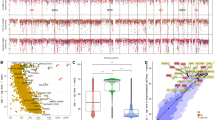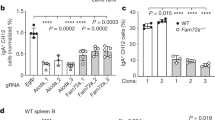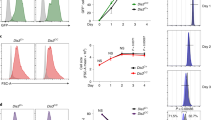Abstract
Somatic hypermutation introduces point mutations into immunoglobulin genes in germinal centre B cells during an immune response. The reaction is initiated by cytosine deamination by the activation-induced deaminase (AID) and completed by error-prone processing of the resulting uracils by mismatch and base excision repair factors1. Somatic hypermutation represents a threat to genome integrity2 and it is not known how the B cell genome is protected from the mutagenic effects of somatic hypermutation nor how often these protective mechanisms fail. Here we show, by extensive sequencing of murine B cell genes, that the genome is protected by two distinct mechanisms: selective targeting of AID and gene-specific, high-fidelity repair of AID-generated uracils. Numerous genes linked to B cell tumorigenesis, including Myc, Pim1, Pax5, Ocab (also called Pou2af1), H2afx, Rhoh and Ebf1, are deaminated by AID but escape acquisition of most mutations through the combined action of mismatch and base excision repair. However, approximately 25% of expressed genes analysed were not fully protected by either mechanism and accumulated mutations in germinal centre B cells. Our results demonstrate that AID acts broadly on the genome, with the ultimate distribution of mutations determined by a balance between high-fidelity and error-prone DNA repair.
This is a preview of subscription content, access via your institution
Access options
Subscribe to this journal
Receive 51 print issues and online access
$199.00 per year
only $3.90 per issue
Buy this article
- Purchase on Springer Link
- Instant access to full article PDF
Prices may be subject to local taxes which are calculated during checkout



Similar content being viewed by others
References
Di Noia, J. M. & Neuberger, M. S. Molecular mechanisms of antibody somatic hypermutation. Annu. Rev. Biochem. 76, 1–22 (2007)
Kuppers, R. & Dalla-Favera, R. Mechanisms of chromosomal translocations in B cell lymphomas. Oncogene 20, 5580–5594 (2001)
Shen, H. M., Peters, A., Baron, B., Zhu, X. & Storb, U. Mutation of BCL-6 gene in normal B cells by the process of somatic hypermutation of Ig genes. Science 280, 1750–1752 (1998)
Pasqualucci, L. et al. BCL-6 mutations in normal germinal center B cells: evidence of somatic hypermutation acting outside Ig loci. Proc. Natl Acad. Sci. USA 95, 11816–11821 (1998)
Gordon, M. S., Kanegai, C. M., Doerr, J. R. & Wall, R. Somatic hypermutation of the B cell receptor genes B29 (Ig beta, CD79b) and mb1 (Ig alpha, CD79a). Proc. Natl Acad. Sci. USA 100, 4126–4131 (2003)
Muschen, M. et al. Somatic mutation of the CD95 gene in human B cells as a side-effect of the germinal center reaction. J. Exp. Med. 192, 1833–1839 (2000)
Pasqualucci, L. et al. Hypermutation of multiple proto-oncogenes in B-cell diffuse large-cell lymphomas. Nature 412, 341–346 (2001)
Parsa, J. Y. et al. AID mutates a non-immunoglobulin transgene independent of chromosomal position. Mol. Immunol. 44, 567–575 (2007)
Wang, C. L., Harper, R. A. & Wabl, M. Genome-wide somatic hypermutation. Proc. Natl Acad. Sci. USA 101, 7352–7356 (2004)
Longerich, S., Basu, U., Alt, F. & Storb, U. AID in somatic hypermutation and class switch recombination. Curr. Opin. Immunol. 18, 164–174 (2006)
Fagarasan, S. et al. Critical roles of activation-induced cytidine deaminase in the homeostasis of gut flora. Science 298, 1424–1427 (2002)
Shen, H. M., Michael, N., Kim, N. & Storb, U. The TATA binding protein, c-Myc and survivin genes are not somatically hypermutated, while Ig and BCL6 genes are hypermutated in human memory B cells. Int. Immunol. 12, 1085–1093 (2000)
Rada, C., Di Noia, J. M. & Neuberger, M. S. Mismatch recognition and uracil excision provide complementary paths to both Ig switching and the A/T-focused phase of somatic mutation. Mol. Cell 16, 163–171 (2004)
Shen, H. M., Tanaka, A., Bozek, G., Nicolae, D. & Storb, U. Somatic hypermutation and class switch recombination in Msh6-/-Ung-/- double-knockout mice. J. Immunol. 177, 5386–5392 (2006)
Xue, K., Rada, C. & Neuberger, M. S. The in vivo pattern of AID targeting to immunoglobulin switch regions deduced from mutation spectra in msh2-/-ung-/- mice. J. Exp. Med. 203, 2085–2094 (2006)
Michael, N. et al. The E box motif CAGGTG enhances somatic hypermutation without enhancing transcription. Immunity 19, 235–242 (2003)
Odegard, V. H. & Schatz, D. G. Targeting of somatic hypermutation. Nature Rev. Immunol. 6, 573–583 (2006)
Duquette, M. L., Huber, M. D. & Maizels, N. G-rich proto-oncogenes are targeted for genomic instability in B-cell lymphomas. Cancer Res. 67, 2586–2594 (2007)
Franco, S. et al. H2AX prevents DNA breaks from progressing to chromosome breaks and translocations. Mol. Cell 21, 201–214 (2006)
Ramiro, A. R. et al. Role of genomic instability and p53 in AID-induced c-myc-Igh translocations. Nature 440, 105–109 (2006)
Mullighan, C. G. et al. Genome-wide analysis of genetic alterations in acute lymphoblastic leukaemia. Nature 446, 758–764 (2007)
Janz, S. Myc translocations in B cell and plasma cell neoplasms. DNA Repair (Amst.) 5, 1213–1224 (2006)
Poltoratsky, V., Prasad, R., Horton, J. K. & Wilson, S. H. Down-regulation of DNA polymerase beta accompanies somatic hypermutation in human BL2 cell lines. DNA Repair (Amst.) 6, 244–253 (2007)
Reynaud, C. A., Aoufouchi, S., Faili, A. & Weill, J. C. What role for AID: mutator, or assembler of the immunoglobulin mutasome? Nature Immunol. 4, 631–638 (2003)
Bindra, R. S. & Glazer, P. M. Co-repression of mismatch repair gene expression by hypoxia in cancer cells: Role of the Myc/Max network. Cancer Lett. 252, 93–103 (2007)
Rosenberg, B. R. & Papavasiliou, F. N. Beyond SHM and CSR: AID and related cytidine deaminases in the host response to viral infection. Adv. Immunol. 94, 215–244 (2007)
Epeldegui, M., Hung, Y. P., McQuay, A., Ambinder, R. F. & Martinez-Maza, O. Infection of human B cells with Epstein-Barr virus results in the expression of somatic hypermutation-inducing molecules and in the accrual of oncogene mutations. Mol. Immunol. 44, 934–942 (2007)
Machida, K. et al. Hepatitis C virus induces a mutator phenotype: enhanced mutations of immunoglobulin and protooncogenes. Proc. Natl Acad. Sci. USA 101, 4262–4267 (2004)
Matsumoto, Y. et al. Helicobacter pylori infection triggers aberrant expression of activation-induced cytidine deaminase in gastric epithelium. Nature Med. 13, 470–476 (2007)
Storey, J. D. & Tibshirani, R. Statistical significance for genomewide studies. Proc. Natl Acad. Sci. USA 100, 9440–9445 (2003)
Muramatsu, M. et al. Class switch recombination and hypermutation require activation-induced cytidine deaminase (AID), a potential RNA editing enzyme. Cell 102, 553–563 (2000)
Reitmair, A. H. et al. MSH2 deficient mice are viable and susceptible to lymphoid tumours. Nature Genet. 11, 64–70 (1995)
Nilsen, H. et al. Uracil-DNA glycosylase (UNG)-deficient mice reveal a primary role of the enzyme during DNA replication. Mol. Cell 5, 1059–1065 (2000)
Yu, D. et al. Axon growth and guidance genes identify T-dependent germinal centre B cells. Immunol. Cell Biol. 86, 3–14 (2008)
Klein, U. et al. Transcriptional analysis of the B cell germinal center reaction. Proc. Natl Acad. Sci. USA 100, 2639–2644 (2003)
Alizadeh, A. et al. The lymphochip: a specialized cDNA microarray for the genomic-scale analysis of gene expression in normal and malignant lymphocytes. Cold Spring Harb. Symp. Quant. Biol. 64, 71–78 (1999)
Suzuki, Y., Yamashita, R., Nakai, K. & Sugano, S. DBTSS: DataBase of human transcriptional start sites and full-length cDNAs. Nucleic Acids Res. 30, 328–331 (2002)
Futreal, P. A. et al. A census of human cancer genes. Nature Rev. Cancer 4, 177–183 (2004)
Auer, R. L. et al. Identification of a potential role for POU2AF1 and BTG4 in the deletion of 11q23 in chronic lymphocytic leukemia. Genes Chromosom. Cancer 43, 1–10 (2005)
Neuberger, M. S. et al. Monitoring and interpreting the intrinsic features of somatic hypermutation. Immunol. Rev. 162, 107–116 (1998)
Huang, X. On global sequence alignment. Comput. Appl. Biosci. 10, 227–235 (1994)
Altshuler, D. et al. An SNP map of the human genome generated by reduced representation shotgun sequencing. Nature 407, 513–516 (2000)
Ewing, B. & Green, P. Base-calling of automated sequencer traces using phred. II. Error probabilities. Genome Res. 8, 186–194 (1998)
Ewing, B., Hillier, L., Wendl, M. C. & Green, P. Base-calling of automated sequencer traces using phred. I. Accuracy assessment. Genome Res. 8, 175–185 (1998)
Goossens, T., Klein, U. & Kuppers, R. Frequent occurrence of deletions and duplications during somatic hypermutation: implications for oncogene translocations and heavy chain disease. Proc. Natl Acad. Sci. USA 95, 2463–2468 (1998)
Karolchik, D. et al. The UCSC Table Browser data retrieval tool. Nucleic Acids Res. 32, D493–D496 (2004)
Kent, W. J. et al. The human genome browser at UCSC. Genome Res. 12, 996–1006 (2002)
Subramanian, A. et al. Gene set enrichment analysis: a knowledge-based approach for interpreting genome-wide expression profiles. Proc. Natl Acad. Sci. USA 102, 15545–15550 (2005)
Acknowledgements
We thank C. Rada and M. Neuberger for providing initial samples of DNA from double knockout mice and for comments on the manuscript; L. Staudt, M. Tomayko and M. Shlomchik for unpublished microarray data; S. Fugmann for comments on the manuscript; S. Unniraman for numerous ideas and comments; and D. Tuck for advice on the bioinformatic analysis. We acknowledge the contributions of the Broad Sequencing Platform. This work was supported by a fellowship from the Anna Fuller Foundation (M.L.) and by the Howard Hughes Medical Institute.
Author Contributions M.L. and D.G.S. designed the experiments and M.L. generated all of the sequencing and expression data. M.L., J.L.D. and S.H.K. performed data and statistical analyses and created the figures. D.J.R., J.L.D. and S.H.K. wrote software for sequence analyses. C.G.V. and C.C.G. provided microarray expression data. D.G.S. wrote the paper. All authors commented on the manuscript.
Author information
Authors and Affiliations
Corresponding author
Supplementary information
Supplementary Information
The file contains Supplementary Figures 1-8 and Supplementary Tables 1-2 with Legends. (PDF 1341 kb)
Rights and permissions
About this article
Cite this article
Liu, M., Duke, J., Richter, D. et al. Two levels of protection for the B cell genome during somatic hypermutation. Nature 451, 841–845 (2008). https://doi.org/10.1038/nature06547
Received:
Accepted:
Issue Date:
DOI: https://doi.org/10.1038/nature06547
This article is cited by
-
RIF1 regulates early replication timing in murine B cells
Nature Communications (2023)
-
Frequency and mechanisms of LINE-1 retrotransposon insertions at CRISPR/Cas9 sites
Nature Communications (2022)
-
Multi-platform profiling characterizes molecular subgroups and resistance networks in chronic lymphocytic leukemia
Nature Communications (2021)
-
FAM72A antagonizes UNG2 to promote mutagenic repair during antibody maturation
Nature (2021)
-
Mutational mechanisms shaping the coding and noncoding genome of germinal center derived B-cell lymphomas
Leukemia (2021)
Comments
By submitting a comment you agree to abide by our Terms and Community Guidelines. If you find something abusive or that does not comply with our terms or guidelines please flag it as inappropriate.



